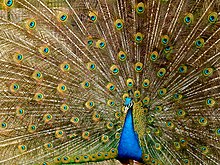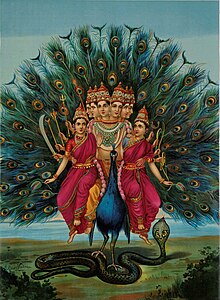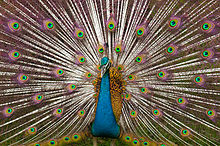Peafowl
| Peafowl | |
|---|---|

| |
| Male Indian Peacock on display. The elongated upper tail coverts make up the train of the Indian peacock. | |
| Scientific classification | |
| Kingdom: | |
| Phylum: | |
| Class: | |
| Order: | |
| Family: | |
| Subfamily: | |
| Genus: | |
| Species | |
Peafowl are two Asiatic species of flying birds in the genus Pavo of the pheasant family, Phasianidae, best known for the male's extravagant eye-spotted tail, which it displays as part of courtship. The male is called a peacock, the female a peahen, and the offspring peachicks.[1] The adult female peafowl is grey and/or brown. Peachicks can be between yellow and a tawny colour with darker brown patches. The term also embraces the Congo Peafowl, which is placed in a separate genus Afropavo.
The species are:
- Indian Peafowl, Pavo cristatus, a resident breeder in South Asia. The peacock is designated as the national bird of India and the provincial bird of Punjab.
- Green Peafowl, Pavo muticus. Breeds from Burma east to Java. The IUCN lists the Green Peafowl as vulnerable to extinction due to hunting and a reduction in extent and quality of habitat.
- Congo Peafowl Afropavo congensis.
Plumage
The male (peacock) Indian Peafowl has iridescent blue-green or green coloured plumage. The peacock tail ("train") is not the tail quill feathers but the highly elongated upper tail coverts. The "eyes" are best seen when the peacock fans its tail. Like a cupped hand behind the ear the erect tail-fan of the male helps direct sound to the ears. Both species have a crest atop the head. The female (peahen) Indian Peafowl has a mixture of dull green, brown, and grey in her plumage. She lacks the long upper tail coverts of the male but has a crest. The female can also display her plumage to ward off female competition or signal danger to her young.

The Green Peafowl appears different from the Indian Peafowl. The male has green and gold plumage and has an erect crest. The wings are black with a sheen of blue. Unlike the Indian Peafowl, the Green Peahen is similar to the male, only having shorter upper tail coverts and less iridescence. It is difficult to tell a juvenile male from an adult female.
As with many birds, vibrant plumage colours are not primarily pigments, but optical interference Bragg reflections, based on regular, periodic nanostructures of the barbules (fiber-like components) of the feathers. Slight changes to the spacing result in different colours. Brown feathers are a mixture of red and blue: one colour is created by the periodic structure, and the other is a created by a Fabry–Pérot interference peak from reflections from the outer and inner boundaries. Such interference-based structural colour is important for the peacock's iridescent hues that change and shimmer with viewing angle, since unlike pigments, interference effects depend on light angle.
Colour mutations exist through selective breeding, such as the leucistic White Peafowl and the Black-Shouldered Peafowl.
Evolution
Charles Darwin first theorized in On the Origin of Species that the peacock's plumage had evolved through sexual selection. This idea was expanded upon in his second book, The Descent of Man and Selection in Relation to Sex.
The sexual struggle is of two kinds; in the one it is between individuals of the same sex, generally the males, in order to drive away or kill their rivals, the females remaining passive; whilst in the other, the struggle is likewise between the individuals of the same sex, in order to excite or charm those of the opposite sex, generally the females, which no longer remain passive, but select the more agreeable partners.[2]
Seven year study of free living peacocks, conducted in Japan came to the conclusion that female peahens are virtually indifferent towards the male display of plumage.[3] This study cast serious doubts on a long held belief of the role of sexual selection in forming the brilliant plumage of male peacock.
Joseph Jordania recently suggested that the peacock's brilliantly colored and oversized tail, as well as its piercing, loud call, evolved through the forces of natural selection, not sexual selection, and were primarily designed to intimidate rivals and competitors, not to attract females.[4]
Behaviour
Peafowl are forest birds that nest on the ground but roost in trees. They are terrestrial feeders.
Both species of peafowl are believed to be polygamous. However, it has been suggested that peahens entering a green peacock's territory are really his own juvenile or sub-adult young (K. B. Woods in lit. 2000) and that green peafowl are really monogamous in the wild. The peacock flares out his feathers when he is trying to get the peahen's attention.
During the mating season they will often emit a very loud high-pitched cry. They also travel in hunting packs between ten and ninety.
Diet
Peafowl are omnivorous and eat most plant parts, flower petals, seed heads, insects and other arthropods, reptiles, and amphibians.
In common with other members of the Galliformes, males possess metatarsal spurs or "thorns" used primarily during intraspecific fights.
Feral populations

Peafowl have left captivity and developed permanent, free-roaming populations in India, Japan, and England.[5] There are permanent feral populations in Metropolitan South Florida that are protected by law. Musters of peafowl are frequently seen in the Coconut Grove area of Miami and near Biscayne Bay in the municipalities of Palmetto Bay and Cutler Bay. They have been a source of controversy in Miami-Dade County for years.[6] These peafowl may be descendents of birds dispersed by Hurricane Andrew from the Wings of Asia aviary at the Miami Dade Zoological Park and Gardens in 1992. They are also a source of controversy on the Palos Verdes Peninsula, CA, where many residents cherish and nurture the birds, and many others loathe them and lobby for their removal from the affluent area. The area's peacock population is descended from 16 birds given as a gift to Frank Vanderlip by a member of the Wrigley family in the 1920s.
Cultural significance

In Hinduism, the Peacock is associated with Saraswati, a deity representing benevolence, patience, kindness, compassion and knowledge. Peacock is also the mount of Hindu God of war Murugan. The peacock is the steed of Kartikay, the brother of Ganesha. Similar to Saraswati, the Peacock is associated with Kwan-yin in Asian spirituality. Kwan-yin (or Quan Yin, Guanyin) is also an emblem of love, compassionate watchfulness, good-will, nurturing, and kind-heartedness. Legend tells us she chose to remain a mortal even though she could be immortal because she wished to stay behind and aid humanity in their spiritual evolution.

In Greco-Roman mythology the Peacock is identified with the goddess Hera (Juno). The eyes upon the peacock's tail comes from Argus whose hundred eyes were placed upon the peacock's feathers by the goddess in memory of his role as the guard of Io, a lover of Zeus that Hera had punished. The eyes are said to symbolize the vault of heaven and the "eyes" of the stars.
In Babylonia and Persia the Peacock is seen as a guardian to royalty, and is often seen in engravings upon the thrones of royalty.

In Christianity, the peacock is an ancient symbol of eternal life.[7] The Peacock symbolism represents the "all-seeing" church, along with the holiness and sanctity associated with it. Additionally, the Peacock represents resurrection, renewal and immortality within the spiritual teachings of Christianity. Themes of renewal are also linked to alchemical traditions too, as many schools of thought compare the resurrecting phoenix to the modern-day Peacock.
Melek Taus (ملك طاووس - Kurdish Tawûsê Melek), the Peacock Angel, is the Yazidi name for the central figure of their faith. The Yazidi consider Tawûsê Melek an emanation of God and a benevolent angel who has redeemed himself from his fall and has become a demiurge who created the cosmos from the Cosmic egg. After he repented, he wept for 7,000 years, his tears filling seven jars, which then quenched the fires of hell. In art and sculpture, Tawûsê Melek is depicted as a peacock. However, peacocks are not native to the lands where Tawûsê Melek is worshipped.
In 1956, John J. Graham created an abstraction of an eleven-feathered peacock logo for American broadcaster NBC. This brightly hued peacock was adopted due to the increase in colour programming. NBC's first colour broadcasts showed only a still frame of the colourful peacock. The emblem made its first on-air appearance on May 22, 1956.[8] The current version of the logo debuted in 1986 and has six feathers (yellow, orange, red, purple, blue, green).
A stylized peacock in full display is the logo for the Pakistan Television Corporation.
In some cultures the peacock is also a symbol of pride or vanity, due to the way the bird struts and shows off its plumage.
References
- ^ peacock - Britannica Online Encyclopedia
- ^ Darwin, C. (1871) The Descent of Man and Selection in Relation to Sex John Murray, London
- ^ “Male Peacock’s Feather Fails to Impress Females”, 2008
- ^ Joseph Jordania, Why do People Sing? Music in Human Evolution. Logos, 2011
- ^ http://www.bbc.co.uk/news/uk-england-hampshire-15172161
- ^ http://eyeonmiami.blogspot.com/2008/10/coconut-groves-damn-peacocks-residents.html
- ^ Wilson, Ralph F. "Peacock as an Ancient Christian Symbol of Eternal Life". Jesus Walk Bible Study Series. Retrieved January 18, 2011.
- ^ The New York Times Encyclopedia of Television by Les Brown (Times Books, a division of Quadrangle/The New York Times Book Company, Inc., 1977), ISBN 0-8129-0721-3, p. 328
External links
- Peafowl Varieties Database
- The Peacock Pages: All About Peacocks!, An article by Lisa Johnson from the Game Bird and Conservationists' Gazette — Aspects of the cultural role of peafowl and their place in aviculture.
- United Peafowl Association Knowledge Base
- Behavioural Ecologists Elucidated How Peahens Choose Their Mates, And Why, an article at Science Daily
- Peafowl videos, photos & sounds on the Internet Bird Collection
- Peacock — Etymology of the word

